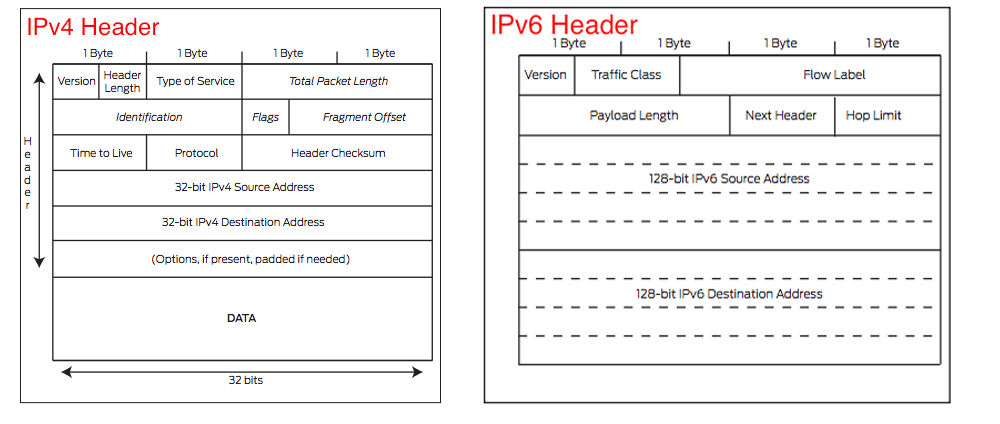What is the difference between IPv4 and IPv6?
What is the difference between IPv4 and IPv6?
IPv6 (IP version 6), defined in RFC 2460, is the most recent generation of the Internet Protocol (IP) defined by the Internet Engineering Task Force (IETF). The first stable version of Internet Protocol (IP) was IPv4 (IP version 4). Whereas IPv6 is intended to eventually replace IPv4, they are tightly mingled right now—most engineers run them together.

Benefits of Using IPv6
The IP layer of the TCP/IP protocol stack is the most crucial piece of the whole Internet architecture. However, within ten years of IP going mainstream in the 1980s, the limitations of IPv4 in terms of scalability and capability became obvious. IPv4 requires several add-ons like ICMP and ARP to function. By the mid-1990s, a replacement scheme was developed. The move to IPv6 is necessary to accommodate the explosion of Internet requirements, Internet technology profile mandates that access via IPv4 and access via IPv6 have to coexist.
IPv6 offers these improvements over IPv4:
- More efficient routing without fragmenting packets
- Built-in Quality of Service (QoS) that distinguishes delay-sensitive packets
- Elimination of NAT to extend address space from 32 to 128 bits
- Network layer security built-in (IPsec)
- Stateless address auto-configuration for easier network administration
- Improved header structure with less processing overhead
How Do IPv4 and IPv6 Work?
- The 128-bits in the IPv6 address are eight 16-bit hexadecimal blocks separated by colons. For example, 2dfc:0:0:0:0217:cbff:fe8c:0.
- IPv4 addresses are divided into “classes” with Class A networks for a few huge networks, Class C networks for thousands of small networks, and Class B networks that are in between. IPv6 uses subnetting to adjust network sizes with a given address space assignment.
- IPv4 uses class-type address space for multicast use (224.0.0.0/4). IPv6 uses an integrated address space for multicast, at FF00::/8.
- IPv4 uses “broadcast” addresses that forced each device to stop and look at packets. IPv6 uses multicast groups.
- IPv4 uses 0.0.0.0 as an unspecified address, and class-type address (127.0.0.1) for loopback. IPv6 uses :: and ::1 as unspecified and loopback address respectively.
- IPv4 uses globally unique public addresses for traffic and “private” addresses. IPv6 uses globally unique unicast addresses and local addresses (FD00::/8).
Juniper Networks Implementation
Juniper Networks complies with RFC 5952 in the standard assignment and display rules for IPv6 addresses. These rules mean that devices must accept all methods of address entry.
Junos Address Aware is an addressing and tunneling software portfolio for the MX Series routers that helps network operators conserve and extend their IPv4 address pool, ensure IPv4/IPv6 coexistence, and pragmatically transition to IPv6.
IPv4 vs IPv6 FAQs
Why are we switching from IPv4 to IPv6?
With the rapid growth of the Internet, enhancements to its IPv4 addressing scheme are needed to support the influx of new subscribers, Internet-enabled devices, and applications. Built upon the functionality of IPv4, IPv6 is designed to enable the continued global expansion of the Internet by creating a much larger pool of IP addresses while also providing improvements to Internet addressing, configuration, maintenance, and security capabilities.
Can you use both IPv4 and IPv6?
Yes. A device that supports dual-stack IPv4/IPv6 addressing can interoperate equally with IPv4-only, IPv6-only, and other dual-stacked IPv4/IPv6 devices. When two communicating devices are both dual stacked, they agree on which IP version to use.
Which is faster: IPv4 or IPv6?
In theory, IPv6 should be faster. However, owing to the larger packet sizes that IPv6 uses, it might be slower in some use cases.
Which type of interface card supports Carrier-Grade Network Address Translation (CGNAT)?
The Junos OS enables its users to implement and scale their CGNAT solutions based on the type of service interfaces used for the implementation. The MS-MPC, MS-MIC, and MX-SPC3 interface cards for Juniper MX Series Universal Routing Platforms, for example, perform compute-intensive CGNAT services.






















